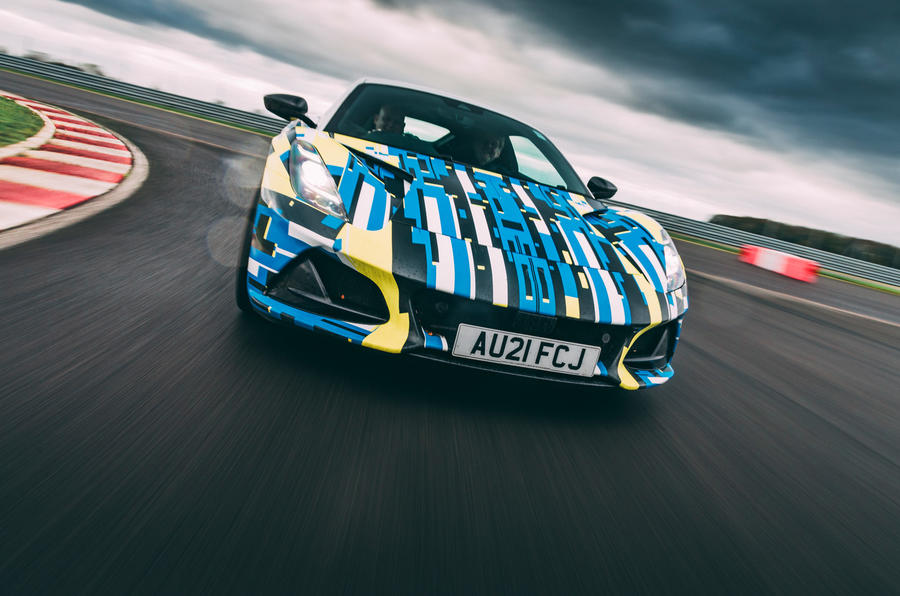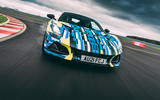“We’ll do a few laps in the electrical car,” says Gavan Kershaw, standing beside a Lotus Emira prototype outside Lotus’s impressive new Hethel HQ.
It’s an odd-looking machine – familiar in shape and basically white, but covered in random colour flashes as if it recently lost a high-speed argument with a random salvo of paintballs.
This word ‘electrical’ is unexpected. Every shred of Emira publicity has so far made it clear that while Lotus is indeed readying an all-new pure-electric sports car for launch in the mid-2020s, this Emira is very much Hethel’s last tilt at “celebrating the glories of combustion”. It isn’t even a hybrid.
The electrical explanation turns out to be undramatic. Lotus currently has around 35 Emira prototypes engaged in final testing in locations all over the world, before production cars start flowing in time for launch. This one belongs to the team in charge of electrical architecture, but Kershaw, the company’s pre-eminent driver and guardian of ‘Lotusness’ (official title: director of vehicle attributes and product integrity) has commandeered it for an hour to show us how it goes on the Hethel test track. There’s no question of a test drive just yet, but I know riding with Kershaw will in some ways be even more instructive.

Doing quick passenger laps with visitors is an ancient Lotus tradition that goes back to Colin Chapman himself. Mike Kimberley, the first post-Chapman MD, did it and so did Roger Becker, Alistair McQueen, John Miles and many other great engineer-drivers since Lotus moved to Norfolk in 1966. Kershaw is very much a bona fide member of that team, having been brought up by a successful motorsport dad before moving as an apprentice into the orbit of McQueen, Miles, Becker and the rest of them. As we prepare to move, his definition of the Emira – which is tilting at 4500 sales a year against a previous total Lotus sports car volume of fewer than 2000 – could hardly be more apposite.








































Join the debate
Add your comment
This article seems to be the o' bait and which, IMHO. It has been reported that the Emira is going to be on the heavy side and while this goes against Mr. Chapman's ago old adage, we have been assured be the Lotus/Emira team that despite this it will be incredible! So with that question in mind, Autocar does a story about the Emira entitled "Worth the weight?" They then say nothing about the weight of the vehicle in the article! Since the article's author didn't drive the vehicle and was only a passenger, despite the click bait in the article's title, I was waiting for the classic 'while not able to drive, FROM THE PASSENGER SEAT...blah, blah, blah)'. Yet, we didn't get that from this article! The title of the article should have been 'Worth the wait?' for it did more to answer that question, then indicated anything about how the Emira's heft will impact it's driving experience!
Agree it's a strange title given the content of the article. End of the day it has basically the same weight and power as the Porsche Cayman GT4. Not had the chance to drive the GT4 but don't think I've ever read that it would be a great car if not for the heft.
Rightly, Artil. It is a tarted up Evora. For good and ill.
There's a lot of hype, but I have a feeling it's going to disappoint. Cabin already looks dated, the V6 powertrain is still a FWD setuo repurposed for this application with a high centre of gravity.
The Evora was always a mixed bag as a driver's machine. Suspect this will be, too.
Rightly or wrongly i assume this is 90% just a rebodied Evora. But given the Evora was said to be a great drive, but no looker that cant be a bad thing. This certainly looks far more appealing.
With these 'ride along' stories i often wonder if they offer certain people a drive anyway as long as they print it didnt happen. It seems only half a story to travel to the factory to be shown what it can do by someone who knows how to get the best from a car, and then go home again.